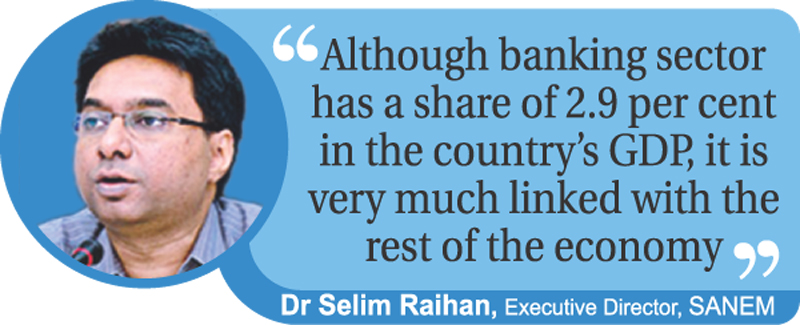Inefficiency in banking sector is causing Bangladesh an annual gross domestic product (GDP) loss of around Tk 100 billion, a leading think-tank - South Asian Network for Economic Modelling (SANEM) - has opined.
"Current inefficient banking sector is generating an annual GDP loss of Tk 10 thousand crores, which is around one per cent of the country's GDP," SANEM said in its quarterly review on Bangladesh economy on Wednesday.
 "Although, banking sector has a share of 2.9 per cent in the country's GDP, it is very much linked with the rest of the economy. There is a huge cost associated with any uncertainty in the banking sector," said Executive Director of SANEM Selim Raihan.
"Although, banking sector has a share of 2.9 per cent in the country's GDP, it is very much linked with the rest of the economy. There is a huge cost associated with any uncertainty in the banking sector," said Executive Director of SANEM Selim Raihan.
The SANEM researchers said due to the unavailability of any overall efficiency measure in the banking sector, they used the ratio of non-performing loans (NPL) to gross loans as a proxy of inefficiency in the sector.
The stunning projection comes at a time when the amount of NPL in the banks has risen to a staggering Tk 800 billion, while the banking sector is also being hit by repetitive scams.
"There has never been such a high concentration of scams in the banks of Bangladesh, as it has been in the recent years," Mr Raihan said while reflecting on the sorry state of banking sector in the country.
The SANEM researchers, however, observed that the crisis is a culmination of the prolonged structural problems in the country's banking sector.
"The leading reason behind the crisis is lack of confidence in the banking sector by the depositors, excessive lending, weak regulation and monitoring, political patronage of inefficient people as well as lack of independence of Bangladesh Bank (BB)," Selim Raihan said.
Reflecting on the lack of freedom of BB, he said, recently a number of major decisions have been taken "bypassing the central bank".
"Such moves have put the role of BB in a dilemma. The duty of regulating the banking sector should be bestowed on the central bank. But as we see, that is not the case on many occasions."
Pointing at the recent government move to allow the state entities to deposit 50 per cent of their funds with the private commercial banks (PCBs) as well as to slash the cash reserve requirement (CRR) by one percentage points, the SANEM researchers observed that both the decisions are "not taken in a proper way".
"Both these decisions should have been taken after going through intense discussion and internal exercise of the central bank's policy-making unit."
"But so far, we have not seen any such step. We think that both these decision are giving a wrong signal," Mr Raihan opined. Reflecting on the decision to allow the state entities to deposit 50 per cent of their funds in the PCBs, the SANEM executive director said if the public money goes to the hands of the banks that are not performing well, there is no guarantee that that money will not be misused.
Highlighting on the decision to slash CRR by one percentage points, Mr Raihan said CRR acts as a safety for the depositors and the banks.
"Therefore, we are not sure whether the decision to slash CRR is a prudent move or not."
Referring to the rising tendency to invest in national savings certificates (NSCs) rather than the bank deposit schemes, he said it is happening for lack of confidence of the depositors on banks. "There is a strong view that the declining growth in deposit is primarily driven by the high growth of NSCs. But it is a valid proposition."
"Figures show that the gap between the interest rates of bank deposits and NSCs is decreasing in the recent years. Still, the rise in the sales of savings certificates is maintaining a highly upward trend."
"This shows that there are some other reasons behind the growing popularity of NSCs, which include lack of confidence in banks," he added.
The SANEM researchers also reflected on the declining share of industry in employment in the country, which they termed "signs of pre-mature de-industrialization".
They blamed it on sluggish private investment, international pressure on domestic working conditions, rise in productivity in manufacturing sector and increased automation in readymade garment sector. They also said the country needs to attract large volume of foreign direct investment, diversify its export basket, enhance competiveness, and significantly improve physical and social infrastructure to sustain its development process.
[email protected]